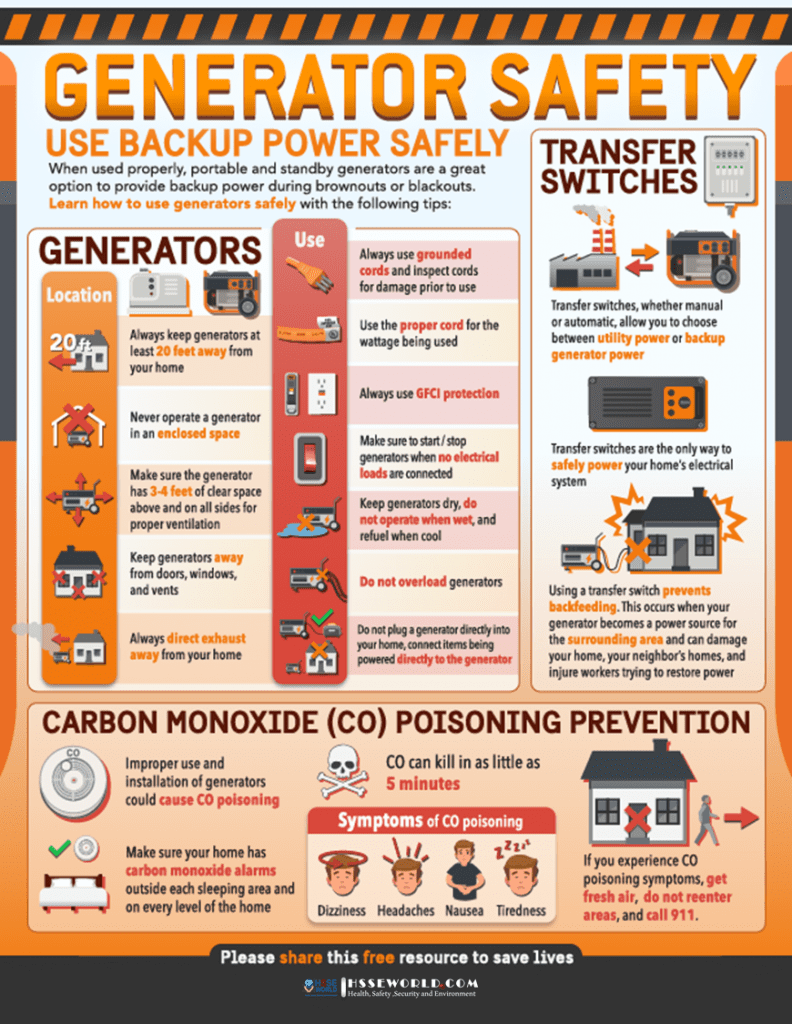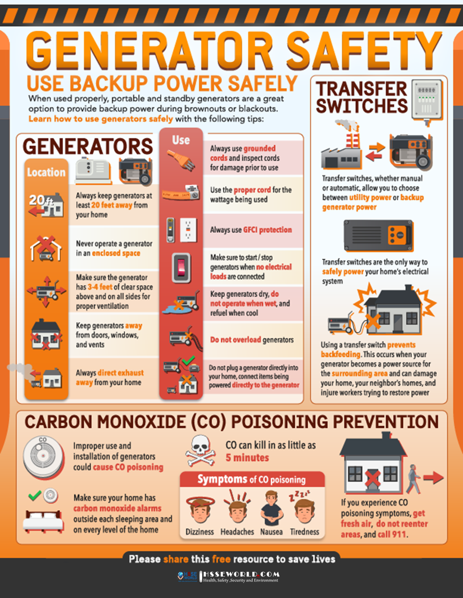Power outages are common during disasters, and they can last for several days. You can reduce your losses and speed the recovery process with an emergency generator.
Portable generators made for household use can provide temporary power to a few appliances or lights. Commercial generators can help prevent service interruptions at businesses and critical infrastructure facilities, such as hospitals, water treatment facilities, telecommunications networks, and emergency response agencies. Local regulations may require you to obtain a permit to operate a generator. in a photo of the day, you will be able to Make sure you follow these regulations when you operate and maintain your generator.

What is diesel exhaust?
Diesel exhaust is produced by the combustion (burning) of diesel fuel. The exhaust is a complex mixture of gases, vapours, aerosols, and particulate substances. The exact nature of the exhaust depends on a number of factors including the type of engine, how well serviced/maintained the engine is, type of fuel, speed and load on the engine, and emission control systems.
Diesel exhaust may contain:
- Carbon (soot)
- Carbon monoxide
- Carbon dioxide
- Oxygen
- Water vapor
- Nitrogen
- Oxides of nitrogen (e.g., nitrogen oxide, nitrogen dioxide)
- Oxides of sulphur (e.g., sulphur dioxide)
- Alcohols
- Aldehydes
- Ketones
- Hydrocarbons
- Polycyclic aromatic hydrocarbons (PAHs)
- Diesel particulate matter (DPM)
What are the main health concerns?
Short-term exposure to diesel exhaust can cause coughing, and irritation of the eyes, nose, throat, and respiratory tract. Breathing in diesel exhaust can cause lung irritation and/or an allergic reaction causing asthma (wheezing and difficult breathing), or making pre-existing asthma worse.
Very high levels can lead to asphyxiation from carbon monoxide poisoning.
Long-term exposure may lead to serious health effects. The International Agency for Research on Cancer (IARC), which is part of the World Health Organization (WHO), classified diesel engine exhaust as carcinogenic to humans (Group 1), determining that exposure to diesel exhaust emissions increases the risk for lung cancer and possibly bladder cancer.
Who is at risk of exposure to diesel exhaust?
The most common way individuals are exposed is by breathing air that contains diesel particulate matter. The fine and ultrafine particles are respirable, which means that the particles can avoid many of the human respiratory system defense mechanisms and enter deeply into the lung.
People may be at risk:
- In areas where diesel-powered vehicles are used such as forklift trucks, railway locomotives, buses, trucks, construction vehicles, farm vehicles.
- Where diesel exhaust can accumulate, such as warehouses, car/bus depots, ferries/ships, garages, vehicle testing sites, fire stations, mines, or where diesel generators or winch motors are used.
- In occupations that work in areas where exhaust levels are high or can accumulate, such as police and traffic officers, custom officer/border control booths, ticket/toll booth operators, drivers of diesel vehicles (buses, subway/railway, truck, taxi, forklift, etc.), airline ground crew, farmworkers, vehicle maintenance workers, dock/cargo ship workers, miners.
How do I know if exposure to diesel exhaust is an issue?
Conduct a risk assessment to determine the health risks from exposure, and to identify the necessary steps needed to control these risks. See the OSH Answers for more information on how to do a risk assessment.
Questions to investigate include:
- How likely is exposure?
- How long is exposure?
- Who/how many are affected?
- Have health concerns been reported?
- Can engines be turned off or idling avoided? Can engines be operated outdoors only?
- Are the engines in good repair?
- How exhaust is currently ventilated or removed from the location?
- Is there visible smoke from the engine?
- Is soot accumulating in the workplace?
- What controls are currently in place?
- How can exposure be reduced or eliminated?
This checklist is not complete. Be sure to investigate all relevant issues for your workplace or situation.
( Download : Electrical-inspection-checklists/)
How can exposure to diesel exhaust be controlled?
Various measures can help lower exposure to diesel exhaust. Workplaces may investigate the measures that work best in their situation. Control measures may include:
- Eliminate by replacing diesel-powered engines with electric or other types of power sources (remember to manage any risks introduced by alternative power sources).
- Use alternate fuels where possible.
- Use low-emission engines.
- Use exhaust treatment systems such as filters, catalysts and/or converters, and a corresponding maintenance program.
- Run engines outdoors (instead of indoors).
- Maintain engines to help with their efficiency.
- Maintain the body of the vehicle to make sure that exhaust is not leaking into the cab or passenger area.
- Modify the layout of the work area to separate the area where people must work and areas where the exhaust is generated, such as isolate the generator in a separate, ventilated space, or isolate the worker in a sealed, air-conditioned cabin (air filtered) where possible.
- Ventilate appropriately, such as providing positive pressure ventilation, exhaust extraction devices, inlet and exhaust general (dilution) ventilation, and/or local exhaust (such as tailpipe hose exhaust).
- Keep openings for the border, ticket, toll, or food booths as small as possible and closed as much as possible when there is exposure to exhaust. If booths are in a place where exhaust accumulates, ventilate the booth with fresh air appropriately.
- Use administrative controls such as:
- Education and training to workers about the exposure to diesel exhaust and proper use of control measures.
- Turning off engines whenever possible.
- Regularly maintaining engines.
- Reduce the hours of work exposed to exhaust through job rotation and scheduling.
- Use of personal protective equipment, such as respirators.
General Safety and Usage Guidelines for Backup Generators
- Be sure to use your generator correctly. Using a generator incorrectly can lead to dangerous situations:
- Carbon monoxide poisoning from engine exhaust. Even if you can’t smell exhaust fumes, you may still have been exposed to carbon monoxide. If you start to feel sick, dizzy, or weak while using a generator, get fresh air right away. If you experience serious symptoms, get medical attention immediately. Consider installing battery-operated carbon monoxide alarms. Be sure to read the manufacturer’s instructions and take proper precautions.
- Electric shock or electrocution.
- Fire.
Use a portable generator only when necessary, and only to power essential equipment.
- Position generators outdoors and well away from any structure. Running a generator inside any enclosed or partially enclosed structure can lead to dangerous and often fatal levels of carbon monoxide. Keep generators positioned outside and at least 15 feet away from open windows so exhaust does not enter your home/business or a neighboring home/business.
- Keep the generator dry. Operate your generator on a dry surface under an open, canopy-like structure and make sure your hands are dry before touching the generator. Do not use the generator in rainy or wet conditions.
- Disconnect the power coming into your home/business. Before you operate your generator, disconnect your normal source of power. Otherwise, power from your generator could be sent back into the utility company lines, creating a hazardous situation for utility workers.
- Make sure your generator is properly grounded. Grounding generators can help prevent shocks and electrocutions. Refer to OSHA guidelines for grounding requirements for portable generators.
- Plug equipment directly into the generator. Use heavy-duty, outdoor-rated extension cords that are in good working condition and have a wire gauge that can handle the electric load of any connected appliances.
- DO NOT plug the generator into a wall outlet. NEVER try to power your house/business by plugging the generator into a wall outlet or the main electrical panel. Only a licensed electrician should connect a generator to a main electrical panel by installing the proper equipment according to local electrical codes. Make sure the electrician installs an approved automatic transfer switch so you can disconnect your home’s wiring from the utility system before you use the generator.
- Maintain an adequate supply of fuel. Know your generator’s rate of fuel consumption at various power output levels. Carefully consider how much fuel you can safely store and for how long. Gasoline and diesel fuel stored for long periods may need added chemicals to keep them safe to use. Check with your supplier for recommendations. Store all fuels in specifically designed containers in a cool, dry, well-ventilated place, away from all potential heat sources.
- Turn the generator off and let it cool before refueling. Use the type of fuel recommended in the manufacturer’s instructions.
- Inspect and maintain your generator regularly. Check aboveground storage tanks, pipes, and valves regularly for cracks and leaks, and replace damaged materials immediately. Tanks may require a permit or have to meet other regulatory requirements. Purchase a maintenance contract and schedule at least one maintenance service per year, such as at the beginning of every hurricane season. Keep fresh fuel in the tank, and run the generator periodically to ensure it will be ready when you need it.
( Read more:how to work-safely-with-portable-generators/)
Download Infographic
Generator Safety
More Photos
- What are the Best Practices for Managing Subcontractor Risk
- Photo of the day: 10 Essential Safety Tips for Driving in Hot Weather Conditions
- Photo of the day: best workplace safety tips
- Photo of the day: The Importance of Stop Work Authority in Maintaining Workplace Safety
- Photo of the day: Tomorrow’s Reward for Working Safely Today: Cultivating a Culture of Safety
- Photo of the day: Preventing slips and trips at work
- Photo of the day: Learn the DRSABCD action Plan
- Working with Electricity Electrical Accidents Guide for Electrical Workers
- Photo of the day: Hearing Protection Device Selection
- Photo of the day: If An Earthquake Shakes You-Infographic free
- Fire Safety Posters Free Download
- Photo of the day: First Aid for Electrical Burns-Infographic free
- Infographic: First Aid for Cuts and Scrapes free download
- Photo of The day: Work Safe with Lasers-Laser Safety free
- Photo of the day: Working Safely with chemicals and chemical Management
- Photo of the day: Safe work practices when using MEWPs ( updated)
- Photo of the day: Preventing Common Kitchen Hazards
- Photo of the day: Safe handling of Gas Cylinders and lecture bottles
- Photo of the day: Forklift Stability Triangle
- Photo of the day: Defective Tools Safe Work Practice
- Photo of the day: Lift With Your Legs Not With Your Back
- Photo of the day: First Aid for burns
- Photo of the day: The 7 Principles of HACCP
- Photo of the day: Working Safely with Suspended Loads
- Photo of the day: Heat Stroke First Aid and safety posters
- Photo of the day: Near-Miss Reporting and Posters
- Photo of the day: Ergonomic chair and office chair safety tips
- Photo of the day: Whole Body Vibration
- Photo of the day: Substation Safety Equipment
- Photo of the day: Bypassing Safety Controls Rules
- Photo of the day: Lightning Safety Tips
- Photo of the day: Overhead Power lines Clearance
- Photo of the day: Floor Marking
- Photo of the day: Types of Foot Protection
- Photo of the day: Types of Hand Protection
- Photo of the day: Lockout and Tagout Safety
- Photo of the day: Fall Protection Plans
- Photo of the day: Flood Safety Tips
- Photo of the day: Read All Labels Work safe
- Photo of the day: Run Project safely with Crane Hand Signals
- Photo of the day: Flagman and Traffic control
- Photo of the day: Managing Risks of Exposure to Solvents in the workplace
- Photo of the day: Scissor Lift Safety
- Photo of the day: HSE Bulletin Board
- Photo of the day: Arc-Fault Circuit Interrupters (AFCI)
- Photo of the day: Safe use of ladders and step ladders
- Photo of the day: Concrete Truck Driver Hand Signals
- Photo of the day: Extension Cord Safety Tips
- Photo of the day: Protect your Head
- Photo of the day: choosing the right Anchorage
- Photo of the day: Work-Related Asthma
- Photo of the day: Top FIVE Heavy Equipment Construction Site Safety Tips
- Photo of the day: sun safety in the workplace
- Photo of the day: Cannabis and Impairment in the Workplace
- Photo of the day: Position for safety and comfort-Safety Tips
- Photo of the day: Generator Safety
- Photo of the day: Controlling COVID-19 in the Workplace-Physical Barriers
- Photo of the day: Manual Material handling
- Photo of the day: Personal Protective Equipment last resort
- Photo of the day: WHMIS 2015 – Pictograms
- Photo of the day: Indoor Air Quality
- Photo of the day: Noise in the affected workplace
- Photo of the day: Fatigue at Work
- Photo of the day: Don’t be Driven to Distraction
- Photo of the day: working in heat and Humidex Rating
- How to use Plate Clamps Safely: Safety Moment#34
- Photo of the day: Sitting at work
- Photo of the day: 5 ways to reduce the risk of Slipping and Tripping
- Photo of the day: Preventing the spread of contagious illness
- Photo of the day: Incident Investigations
- Photo of the day: 10 Scaffold Safety Essentials
- Photo of the day: Effective Health and Safety Committees
- Photo of the day: New worker Orientation & Safety Orientation checklist
- Photo of the day: Workplace Inspection
- Photo of the day: musculoskeletal disorders
- Photo of the day: Emergency preparedness in the workplace
- Photo of the day: Mental health in the workplace
- Photo of the day: Trenching Safety Tips That Can Save a Life
- Photo of the day: Dangerous Goods Classes
- Photo of the day: Safety Equipment for Confined Spaces
- Photo of the day: Tips to reduce Heat stress in the workplace
- Photo of the day: hierarchy of controls
- Your steps to chemical safety
- H2S Gas and how to handle its Emergency
- Photo of the day: Importance of Mock drill and Fire Action Emergency Procedure
- Photo of the day: Choosing the Right Face Mask and the difference between a respirator and face mask
- Photo of the day: Confined space safety Precautions
- Breath Safely: The Proper Use of Respiratory Protection
- Photo of the day: Electric shock survival
- Photo of the day: Chemical Spill Emergency Response
- Photo of the day: Construction Site fire Safety




